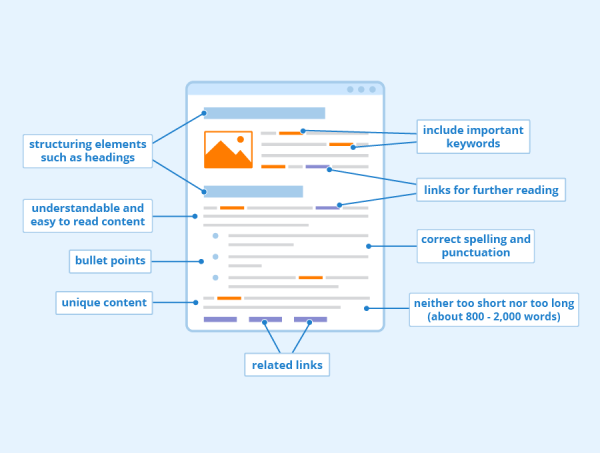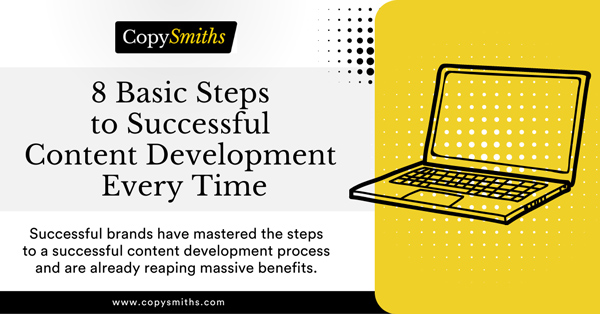Every brand creates content with the hope of witnessing incremental successes that will build up over time.
But this is only possible with the right content development strategy and process, which eventually helps to:
- Build your audience
- Improve subscriptions and convert them to sales
- Fill knowledge gaps in the industry
- Understand your audience’s needs and interests
Taking a more thoughtful approach to content development will help you avoid publishing new ideas on your website just for the sake of remaining relevant.
Successful brands have mastered the steps of a successful content development process and are already reaping massive benefits.
Luckily, these eight steps are simple and can be easily adopted by any brand, including yours.
1: Establish Your Content Goals and Ideas
The first step to creating successful content development is knowing what you want your content to accomplish.
Are you looking to increase email sign-ups or daily site views? Do you want to create content that drives sales right away? What about your brand’s voice, is it conversational or educational?
Having a clear idea of what you want to achieve will influence the nature and format of your content.
If, for instance, you want to create product awareness and reach a new audience, opt for a blog post that covers a broad topic related to your brand.
The table below lists four key types of blog posts that are worth investing in.
| Type Of Blog Content | Why It’s Worth Your Investment |
| How To Guides |
|
| Listicles |
|
| Customer Buying Guides |
|
| Product Descriptions |
|
Learn More: 4 Types of Blog Content That Are Worth the Investment
Without a concrete goal to focus on, you’ll end up churning out content just for the sake of it, which eventually adds little to no value to your eCommerce store.
2: Conduct Thorough Research on the Topic or Idea
Sure, you may know a lot about your product or service, but you can miss crucial details when putting those thoughts down on paper if you don’t have a reference page to turn to.
Conducting thorough research helps to keep your content flowing and provides your readers with key takeaways.
Below are some of the various ways of performing content research:
- Idea exploration: Delve deeper into your chosen topic or idea by noting the information you already have about it and what else you’d like to know. This will let you know what specific points need to be searched.
- Competition analysis: Check out your competitors’ sites to identify if there’s an idea they missed that should be included to attract a larger audience.
- Check credible sources: Check every article’s source and content before selecting its link for reference. Credible sources include research articles written by well-known and respected authors, academic databases, and websites registered by educational or government institutions.
Alternatively, hire a content creator to help you manage your blog content. They’ll do all the research and write expertly on any topic.
Related Article: Creating Content In-House vs. Outsourcing: The Pros and Cons of Both
3: Organize and Plan the Content

Writing a rough first draft that details how your subheadings and key points will play out helps to organize your thoughts and keep your content development process in order.
That’s why it’s crucial to draft an outline. It will help you to create a rich, in-depth article and directly inform your content’s flow and structure.
Outlining helps you determine the article’s tone and helps you discover which areas need more information before you start writing.
Always follow a simple format with your outline. Keep it to the point and only highlight crucial factors, like what topics to cover, and relevant third-party sources to reference in some sections.
4: Write the Content to Perfection

Here comes the fun part—writing.
Now that you have a clear outline, proceed to write the highest quality and most interesting content to grab your audience’s attention.
Achieve this by:
- Engaging your audience: Keep your content rich and entertaining by including visuals, statistics, interesting facts, and case studies.
- Writing in a unique brand voice: This can be communicated through your article’s tone. Is it educational or conversational? Ensure your brand’s voice remains constant throughout your articles.
- Keeping it simple: Avoid over-explaining, going off-topic, or using complex vocabulary, as this will confuse your readers and drive them away. Instead, streamline your ideas clearly and use simple language from the first to the last sentence.
- Writing plainly: Keep your paragraphs short, words readable, and sentences neat.
Presentation is as important as the words themselves. Make your article stand out from competitors by bolding key concepts, using captivating subtitles, and incorporating bullet lists.
5: Edit and Proofread the Content

Nothing will frustrate your readers or ruin your brand’s reputation more than publishing content filled with avoidable errors.
So polish your content with top-notch editing and proofreading before hitting that publish button.
Here are the key areas to review:
- Scannability and readability: Check that your paragraphs are short and easy to read and that your text is visually appealing for readers.
- Delete anything irrelevant: By now, you already know your target audience and what they’ll deem useful. Eliminate anything otherwise.
- Keep the grammar in check: Make use of editing and proofreading tools like Grammarly.
In most cases, writing improves after a round or two of edits, even if it’s been drafted by a highly experienced content writer.
We recommend taking breaks between writing and proofreading your articles. Stepping away from the article for a couple of hours lets you review your content with a fresh set of eyes that will spot errors easily.
6: Publish the Content
Once you’re done writing and fine-tuning your content, it’s time to send it out into the world.
Successful content development strategies usually include an omnichannel experience where content is posted on several platforms simultaneously. Of course, the format of the content should be optimized to suit each platform.
These platforms include your eCommerce website, Facebook, Twitter, and even Instagram. But only select those accessible to your intended audience for effective marketing.
7: Promote Your Content to Enhance Visibility and Engagement
With so much content being produced and posted every second, you’ll need a solid content distribution strategy to ensure yours reaches your intended audience.
An excellent way to promote your content is through social media. There are over 4 billion social media users worldwide, who each spend an average of 144 minutes per day on this activity.
A post linking your new content to your company’s social media platforms may be the cheapest and quickest method of promoting it.
Other ways of promoting your content include:
- Creating paid ads to reach a larger audience
- Building backlinks to your article
- Working with an influencer or expert in your industry
- Engaging in your brand conversations on different social channels
8: Monitor and Measure Your Content’s Performance
The final step to successful content development is to analyze the performance of your content.
The content development process never ends; it only improves with each cycle.
Maintaining a successful blog requires you to consistently monitor and measure its performance.
Did you reach your short-term goals? Is your audience engaging with your content? What can you do to improve it?
As you monitor the successes, failures, and feedback of your content, you can begin to adjust your overall strategy accordingly.
Making observable changes will help you craft high-quality content that meets your audience’s needs.
Effective Writing Is the Key to a Successful Content Development Process
Creating a successful content development process is incomplete without highly-curated content that communicates your business values.
A professional will expertly capture your brand’s look, feel, tone, and voice through quality content that will keep your audience hooked and turn your site’s visitors into informed customers.
So if you’re looking to generate useful content ideas and write them in a captivating way, make use of content creation services that have proven track records of success. They may be the boost your eCommerce store needs.
“The content that the CopySmiths team has developed for ServiceSeeking is first-rate, and we’ve seen organic rankings for highly prized keywords increase, driving more new visitors and signups.” Oliver Pennington, ServiceSeeking
Share on LinkedIn:

